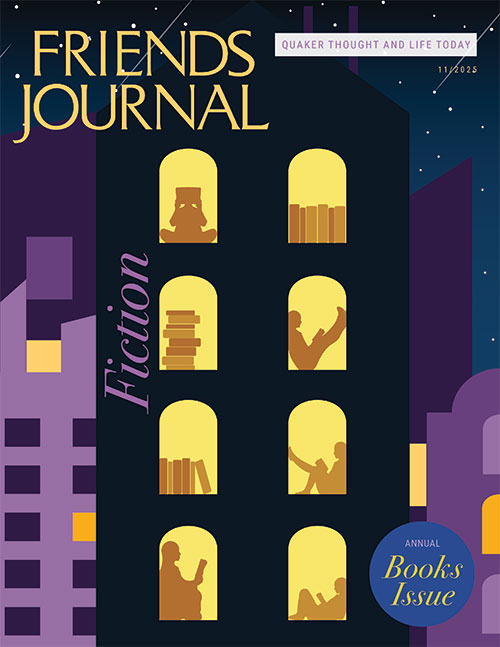Supporting those with direct experience of the Divine
I’m grateful to the editors of What Canst Thou Say? (“News” by Sharlee Dimenich, FJ Oct., Sept. online) who have provided the WCTS newsletter for so many years, as well as several wonderful gatherings as a way to encourage the sharing of profound spiritual experiences and to support those who have had direct experiences of the Divine, which can sometimes be overwhelming and require support in integrating into one’s life in a healing and growth-producing way. The volunteer editors have worked hard and lovingly for a very long time. I’m glad to see this recognition of their work in Friends Journal.
Marcelle Martin
Chester, Pa.
Expanding the concept of affinity groups
Reading the October issue of Friends Journal, I learned about affinity groups—a form of gathering new to me. Was the group of parents loosely connected to New England Yearly Meeting such a group? This group has been meeting for over five years. Parents come from near and far—even as far as Australia—to share their experiences of caring for and guiding their children. They explore how their Quaker beliefs and the testimonies and practices guide their parenting. They end their sessions with some silent worship.
The issue made me wonder what other such groups exist and how do they nurture both individuals and our wider Quaker community?
Harriet Heath
Winter Harbor, Maine
Commonalities in religion
Evan Welkin’s “Shining Our Light Before Others” (FJ Sept.) is a good read with an ecumenical message. I have been in a number of places of worship. I did some work for the Carter Center. The project called for a good deal of reading the Qur’an and I came across this message, “You can’t have peace without justice.” There are so many similar messages in most religions. The more I read in this and other religious writings I continue to see that most religions have much more in common than some folks want to admit. That is sad. As Pope Francis taught us “Who am I to judge?”
Ross P. Alander
Tampa, Fla.
Well, maybe all roads do lead to Rome, but apparently not all of them lead to God. However, Rome and Florence are truly wonderful cities to visit. I hope I’ll be able to do it someday.
Thanks for the interesting and wise article. Having read it once, I wanted to read it again, and then again after a while. And every time, I found something to think about, to reflect on, including from my own life.
Gene T.
The new constitution of the Beatitudes
I have a completely different reading of this passage (“Blessed Are the Meek” by Judith Inskeep, FJ Aug.), though these traditional readings are wonderful. I think that the Beatitudes were Jesus’s commentary on inheritance law in the context of the reign of God he was inaugurating. This verse is explicitly about inheritance and his promise when he declared himself the Christ, the Messiah, the Anointed One, in Luke 4:16–30 and proclaimed the Jubilee, which, among other things, returned families to their inheritance, if they had lost them to foreclosure (Lev 25:10).
In this context, “meek” means judicially disenfranchised, those who did not own land and therefore could not represent themselves before their village’s assembly of elders if sued. They were “meek.”
Likewise, the Hebrew “eretz” in this passage can mean “earth.” But the word literally means “land.” In the context of inheritance, it means one’s inheritance: one’s family farm, your land.
So Jesus’s listeners heard this: Blessed are all of you who have lost your land, your farm, your inheritance, because you could not pay your debts, for you shall re-inherit your land, because I have prophetically declared a Jubilee.
But how could Jesus fulfill this promise? The answer is given in Acts 2:43–47 and again in 4:32–37: we will do it for each other. Like Barnabas in Acts 4:36–37, believers with surplus wealth would liquidate some of their assets and give it to the poor. Believers who had lost their inheritance might not be literally returned to their farm, unless the community actually paid off their debt for them; but at least they would not starve.
In Luke 4, Jesus had defined his role as the Christ, as the Messiah, the Anointed One, thus: his mission was to proclaim good news to the poor. The Beatitudes were like planks in the platform of the new “constitution” he was proclaiming. He was proclaiming an economics of redemption—the forgiveness of debts (“forgive us our debts as we forgive our debtors”)—in the common-wealth of God (Acts 4:32–34).
Steven Davison
Pennington, N.J.
I have been in a Quaker Bible study for five years via Zoom. I’ve found when Quakers search the “word” deep reflections come out. There is a sense of light that I encourage others to witness and not be afraid of what the world says. I find members offer love, grace, and mercy when in discussions. It’s quite remarkable.
Steve Whinfield
Cheshire, Conn.
More marriage milestones
North Meadow Circle of Friends in Indianapolis, Ind., had not had any marriages under its care when in 1986 a heterosexual couple requested the meeting to consider taking under its care marriages of lesbians and gays, as well as heterosexual couples (“A Union Unlike Any Other” by Sharlee DiMenichi, FJ Aug.). In 1987 the meeting united on such a minute supporting same-sex marriage. That same year a lesbian couple was married under care of North Meadow Circle of Friends. This may have been one of the first same-sex marriages under the care of a Friends meeting in the United States.
Michael J. Fallahay
Indianapolis, Ind.
One milestone in the process of acceptance of same-sex marriage was not in the article. Goshen (Pa.) Meeting performed a marriage between myself and Daniel Burgoon under its care on October 27, 1990.
In 1988 I applied to become a member of Goshen Meeting. Everyone in the meeting knew my partner Dan and I had been together for ten years. At my clearness for membership, one member of the meeting said to me, “Phil, you know that this meeting has never discussed whether we would perform ceremonies of commitment for same-sex couples, and I don’t know what the meeting would decide. Would you still want to be a member, even if we decide not to do so?” I realized that I loved this meeting and its members more than I wanted a ceremony of commitment. So I joined the meeting.
A year later I asked the meeting to discuss whether they would perform ceremonies of commitment. The meeting began threshing the concern. Threshing sessions were held once or twice a month for a year, and were very well attended. I did not attend because I wanted to give Friends space to speak openly. The contents of threshing sessions were not reported back to the meeting. I had given up thinking that Friends in the meeting were ever going to come to unity on ceremonies of commitment if they were still threshing it a year later.
Then the clerk, Betsy Balderston, came to me and said the meeting had for the last several months been threshing what marriage was. They concluded it was not a legal event, but rather a religious event. Marriage was two people who love each other, who commit themselves to each other, and who involve God in their relationship. They decided that definition applied to Dan and me, and so no minute was required. They would simply accept an application for marriage from us and treat it as any other application for marriage.
Dan and I were married under the care of the meeting. Dan died in 2001, but the meeting did take us under its care for the rest of our marriage. Goshen Meeting was truly Spirit-led.
Philip Fitz
Northampton, Mass.
I read “A Union Like Any Other” last week with tremendous enthusiasm. I appreciate the way its author highlighted the dynamics and complexities that were a part of discernment processes to support same-sex unions in the 1980s and 1990s. These were challenging times, and many community bonds were tested.
As a historian and an academic working on LGBTIAQ+ history myself, I was honestly disappointed that the first same-sex union under the care of a meeting wasn’t mentioned, which celebrated the partnership of Dorsey Green and Margaret Sorrel at University Friends Meeting in Seattle, Wash., in 1981. The first Quaker minute in support of gay marriage came from San Francisco (Calif.) Meeting in 1971, and it was also not mentioned in the article.
Brian Blackmore
Philadelphia, Pa.





Comments on Friendsjournal.org may be used in the Forum of the print magazine and may be edited for length and clarity.